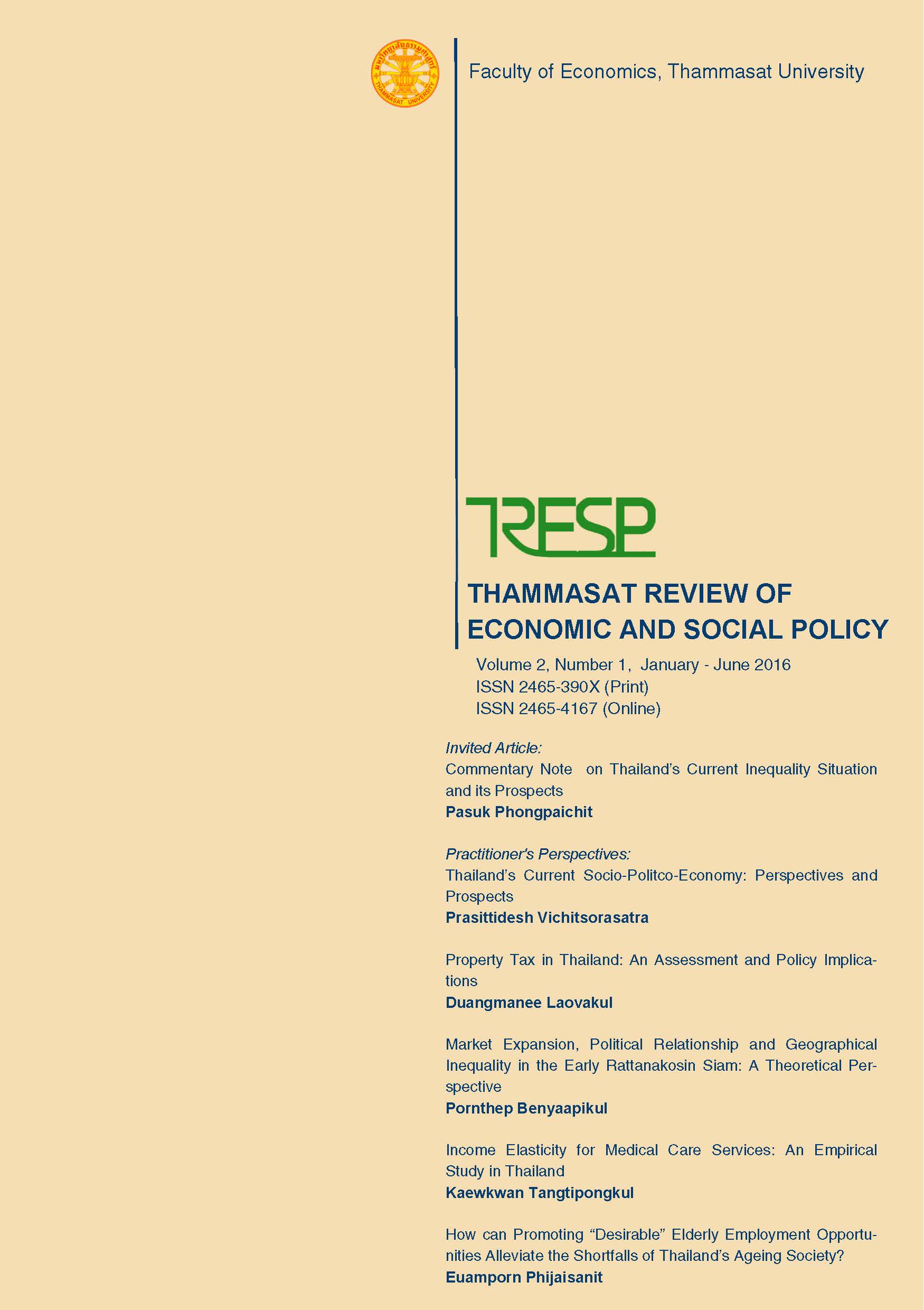Market Expansion, Political Relationship and Geographical Inequality in the Early Rattanakosin Siam: A Theoretical Perspective
DOI:
https://doi.org/10.14456/tresp.2016.4Keywords:
Geography, inequality, market structure, institutional development, ThailandAbstract
This paper provides a simple theoretical model that explains a mechanism for which market economy might proliferate through various geographical locations in the early Rattanakosin Siam and its implication on locational inequality. The proliferation of market economy is often facilitated by a widespread network of merchants and the elite’s profit-maximisation trade incentives. The degree of market expansion in each city depends on elite’s benefits from the market and geographical location of the city. The results suggest four factors that contribute to the level of inequality both within and between cities: social structure, geographical location, individual’s connection with powerful elites and worker’s ability.
References
Acemoglu, D. & Wolitzky, A. (2011). “The Economics of Labor Coercion.”, Econometrica, 79(2), 555-600.
Bates, R. (2001). Prosperity and Violence: The Political Economy of Development., New York: Norton.
Chwe, M. (1990). “Why Were Workers Whipped? Pain in a Principal-Agent Model.”, Economic Journal, 100, 1109-1121.
Dessi, R. & Ogilvie, S. (2004). “The Political Economy of Merchant Guilds: Commitment or Collusion?”, IDEI Working Paper, no.278.
Dessi, R. & Piccolo, S. (2015). “Merchant Guilds, Taxation and Social Capital”, TSE Working Paper, no.581, Toulouse School of Economics.
Eoseewong, N. (2012). Quill and Sails, 4h ed., Bangkok: Sameskybooks Press. (in Thai).
Greif, A. (2006). Institutions and the Path to the Modern Economy: Lessons from Medieval Trade, New York: Cambridge University Press.
Greif, A. (2008). “Coercion and Exchange: How Did Markets Evolve?”, Unpublished manuscript.
Greif, A., Milgrom, P. & Weingast, B. (1994). “Coordination, Commitment, and Enforcement: The Case of the Merchant Guild.”, Journal of Political Economy, 102(4), 745-776.
Hicks, J. (1969). A Theory of Economic History, Oxford UK: Oxford University Press.
Hong, L. (1981). The Evolution of the Thai Economy in the Early Bangkok Period and Its Historiography, PhD thesis, The University of Sydney.
Nartsupha, C. & Manarangsarn, S. (1984). Economic History of Thailand until 1941., Bangkok: Thammasat University Press. (in Thai).
Nash, J. (1950). “The Bargaining Problem.”, Econometrica, 18(2), 155162.
Ogilvie, S. (2011). Institutions and European Trade: Merchant Guilds, 1000-1800, New York: Cambridge University Press.
Ogilvie, S. (2014). “The Economics of Guilds.”, Journal of Economic Perspectives, 28(4), 169-192.
Pomeranz, K. & Topik, S. (2006). The World That Trade Created: Society, Culture, and the World Economy, 1400 to Present, New York: M.E. Sharpe Inc.
Preechametta, A. (2014). “Spatial Dynamics and the Persistence of Inequality in Siam during 1782-1855”, Applied Economics Journal, 21(2), 1-29. (In Thai)
Rabibhadana, A. (1969). The organization of Thai society in the early Bangkok period, 1782-1783., Ithaca, NewYork: Dept. of Asian Studies, Cornell University,
Scott, J. (1972). “Patron-Client Politics and Political Change in Southeast Asia”, American Political Science Review, 66, 91-113.
Scott, J. & Kerkvliet, B. (1973). “The Politics of Survival: Peasant Response to ‘Progress’ in Southeast Asia?, Journal of Southeast Asian Studies, 4(2), 241-268.
Smith, A. (1776). An Inquiry into the Nature and Causes of the Wealth of Nations, Oxford, U.K: Clarendon Press.



